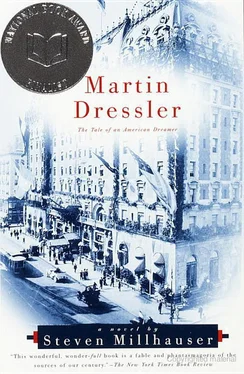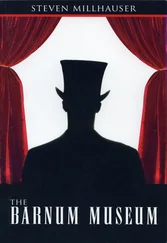Beneath the three levels, and entirely ignored by the journalists, lay the basement, the true bottom of the Dressler, which housed the electric plant, the steam plant, and a warren of workrooms for the maintenance staff.
From the artful rooms and subterranean paths of his high hotel Martin sometimes liked to remove himself in order to look up at the great mass of the building, pierced on each of its facades by an exterior court. It was as if he wanted to hold it all in his eye in a single glance. But what he saw in that glance gave way with a rush to all that he couldn’t see, so that the unseen courts became filled with flowerbeds and gravel walks, the high-arched main entrances on the side streets were immediately connected by a block-long gallery leading to the elevator lobby, each room revealed its furniture, and below the ground, invisible but seen, people walked in the paths of the courtyard and the aisles of the Shopping Arcade and the streets of the Theater District until Martin seemed to hold in his mind the entire contents of the building — and almost reeling under the weight of images he would return inside with a sense of seeking relief from an attack of dizziness.
Martin had taken a modest apartment for himself and Caroline on the sixteenth floor, facing the river, and a second apartment, adjoining theirs, for Emmeline and Margaret. It was Emmeline who understood: the move from the Bellingham to the Dressler had nothing to do with a desire for luxurious living and everything to do with being on the spot. Martin needed to take possession of his creation, to feel it working all around him and through him. He had given the actual job of management to James Osborne, whom he hired away from the Vanderlyn; at first Emmeline had refused the offer of assistant manager, but after a week of brooding she accepted with the understanding that it was only a trial. Daily Martin consulted with Osborne and Emmeline, weekly he attended the meeting of the manager and the department heads, but his passion was to inhabit the Dressler as fully as possible. He ate meals at each of the seven restaurants and tearooms, spoke to the linen-room attendants and seamstresses and chambermaids, sat in the main lobby and listened to guests from behind his newspaper. He examined the steam plant and electric plant in the massive basement beneath the theaters. He strolled in the underground courtyard, bought neckties and umbrellas in the Shopping Arcade, took Caroline and Emmeline and Margaret to a melodrama at the Black Rose. Emmeline had quickly become ardent in her loyalty to the Dressler and often accompanied Martin on his rounds; once, stopping abruptly on a street in the Theater District, she seemed about to say something and then to change her mind. “A penny for your thoughts,” Martin lightly said. Emmeline hesitated a moment before answering. “I was thinking,” she said, “about the castle in the forest, that night,” and Martin was cast suddenly back to the lantern-lit columns, the ladders going down, the moon-glittering edge of the pit.
Although all three underground levels were a striking success, the Theater District in particular was attracting enthusiastic audiences, who after the performances liked to stroll along the cut-stone sidewalks of the six underground streets lit by electric streetlamps and lined by theaters glowing with electric signs. People liked to drink coffee and wine at the two outdoor cafes, or to sit on the slatted wooden benches of a small lamplit park beneath artificial elms, where they could admire the handsome views at the end of each street — views that were in fact large murals painted onto the foundation walls by a commercial artist named Clement Ward who was noted for his skill in depicting urban scenes, especially night scenes showing meticulously drawn cast-iron streetlamps, El stanchions rising to overhead tracks, and the windows of crowded, smoky saloons. Emmeline agreed with Martin that two more cafes were necessary, for many theater-goers preferred to linger in the artificial streets rather than return to the Empire Bar on the first floor or ride to the roof garden under the stars; and Martin discussed with one of the hotel engineers the possibility of fitting the ceiling of the Theater District with very small, very dim electric lights, to create an effect of starlight.
The roof garden was itself a popular spot, with its railed promenade, its flower gardens and small orchard of fruit trees, its scattering of gazebos and Swiss chalets, its red and blue and green Japanese lanterns, and its open-air restaurant of small round tables and canework chairs beneath a roof supported by white wooden posts joined by scrollwork. One rainy summer night when Martin stepped under the roof with Emmeline he saw that the wind was blowing the rain across the floor, so that customers were huddling in one corner. The next morning he arranged for the installation of protective metal screens on spring rollers, which could be lowered during storms.
A few days later Martin asked Emmeline to walk with him from the roof garden down to the boiler room, located in one of the basement divisions beneath the underground theaters. As they descended from landing to landing, Martin was struck by the monotony of the descent: each major stairway landing faced a row of elevator doors and had on each side a door with a window that led to a corridor, while between the elevator landings the stairway turned once to form a secondary landing with a potted plant. The plants exasperated Martin. By the time he reached the main lobby he had decided to have them replaced by varied arrangements of couches, lamps, and bookshelves, so that those who chose to walk would be able to rest along the way. The neat, boring elevator landings posed a more difficult problem. Emmeline suggested artwork of some kind, perhaps framed paintings, and it was Rudolf Arling who took it up, turning over the idea and shaping it into a plan that seized Martin’s interest: in keeping with the theatrical nature of the roof garden and the third underground level, each landing would be designed to convey a different atmosphere. The walls of one landing would be hung with fishing nets and starfish and illuminated by green-blue light, another landing would be supplied with an Ionic column and wall murals of ruined temples and blue sea, a third would have a papier-mâché Indian in authentic garb against a background of thick pine trunks and winding forest paths, the whole bathed in a dark green woodland light.
Although Martin spent a good part of his day inspecting his hotel, talking with workers, and in general considering ways to improve the operation of the Dressler and the well-being of his guests, he also continued his habit of taking long walks in the neighborhood. He liked to follow the progress of excavations, to examine the facades of half-built apartment houses sheathed in scaffolding. Often he would pause thoughtfully before vacant lots. A great burst of building was taking place on the Boulevard, recently renamed Broadway, in anticipation of the new subway that would run under its entire length, but Martin had his eye on a stretch of empty land on Riverside Drive, some ten blocks north of the Dressler. He had reached an understanding with Lellyveld and White, who owned the land and were pleased with the financial reports from the Dressler, and one day after lunch he began meeting again with Rudolf Arling.
All such matters Martin discussed with Emmeline — at lunch, in her office during the day, and at dinner in the main dining room with Caroline and Margaret. Often the four of them took a stroll in the underground courtyard after dinner, after which Caroline would return to her rooms. Margaret was concerned about Caroline. She had seemed so happy in her new apartment with its lovely view, she had looked forward to exploring the new hotel, which she referred to as the Castle — and really, if you thought about it, she was just like a princess in a castle, married to a powerful prince — but she had gradually returned to her old habits, more and more she had confined herself to her apartment, and now you could scarcely coax her to take an after-dinner stroll in the courtyard. And Margaret Vernon, who had been fiddling with her dress collar, would look sharply at Martin, as if to surprise in him the secret of Caroline’s behavior, while Martin, who had grown skeptical about Caroline’s capacity for pleasure, but who at the same time wondered irritably whether he was to blame for not loving her enough, would answer with a touch of impatience that Caroline was welcome to do as she liked.
Читать дальше












